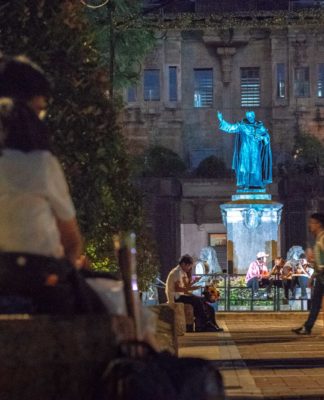EXPECT even heavier traffic for months in the university belt area as the Department of Public Works and Highways (DPWH) has begun widening Lacson Avenue to prepare for the construction of the Lacson flyover.
Sidewalks will be trimmed by five meters to give way to the Japanese-funded flyover, which will be high enough to allow the future Metro Rail Transit Line 9 on España Boulevard to pass underneath.
Danilo Idos, director of the DPWH’s Urban Road Projects Office, said road widening, which began last July 16, includes drainage work, base preparation, application of mixed gravel and binder, and paving of the gutter and sidewalk.
“We will not be closing any road during the widening but traffic flow will be affected as some portions of the outer lane will be occupied by construction equipment,” Idos told the Varsitarian.
The road widening is expected to be finished by December, he said. The flyover, meanwhile, should be up by October next year.
Heavy traffic is expected on Lacson and Recto Avenues, España and Magsaysay Boulevards, and Nagtahan Road, as well as the streets of Dapitan, Lerma, Nicanor Reyes (formerly Morayta), Dimasalang, Vicente Cruz, Maceda, M. de la Fuente, and Legarda.
According to the DPWH, traffic volume in the area has reached saturation, with the level of service placed under category “F” or the “worst condition.” This led to the decision to construct a flyover, which is being opposed by UST.
The 1,440 meter-long flyover, estimated to cost around P1 billion, will be composed of four lanes, stretching from the Lacson-Dapitan intersection to Jhocson Street near España. The distance between the flyover and the UST fence will only be 11.5 meters.
DPWH data obtained by the Varsitarian showed that 4,077 vehicles per hour pass through España Boulevard in the morning peak hours, and 3,426 in the afternoon. On Lacson, 4,318 and 3,393 vehicles per hour pass through in the morning and afternoon peak hours, respectively.
“Once the flyover is opened, travel time will be reduced by more than 50 percent and the delivery of goods will be made faster,” Idos said, adding that gas emissions will also be reduced as vehicles won’t be stuck in heavy traffic.
The DPWH will put up a noise barrier with a height of 2.5 to 3 meters to avoid disturbing hospital patients and classes in the University, and to protect the privacy of nearby residents.
“To erase fears of noise to be created by passing vehicles along the flyover, we will equip the structure with [a] noise barrier capable of arresting noise of considerably high decibel,” the DPWH wrote in a letter to former rector Fr. Rolando de la Rosa, O.P. last April 3.
It added: “There is a proposed landscaping underneath the flyover, hence, there will be aesthetic [improvement] of the area.”
John Joseph Fernandez, dean of the College of Architecture, said the project was supposed to begin last summer, but was delayed as the DPWH had to secure tree-cutting permits from the Department of Environment and Natural Resources.
“If you will observe closely, a lot of trees will be affected. That’s why they (DPWH) had a hard time getting the permit,” Fernandez told the Varsitarian.
Sidewalk trimmed
Aside from cutting trees, the project will require the five-meter reduction of Lacson sidewalks, including the removal of UST Hospital’s Clinical Division ramp.
“The property of the University extends only up to the wall of its perimeter. Anything beyond that is public domain,” Fernandez said. “If you will look at the ramp, it’s actually encroaching on public domain.”
But the University has prepared a “design solution” to avoid problems once the ramp is removed, he said.
“Although UST is a national treasure, it’s still the benefit of the majority that has to be taken into consideration. [The choice is] UST or the entire public. The government has no choice but to go with the public,” Fernandez said.
While delays are a “natural thing” in any construction project, Fernandez said the road widening project was “very untimely” since the rainy season has begun.
Road widening, moreover, is a temporary solution. “[Lacson Avenue] is usually a route being used by trailer trucks going to or leaving the pier going south. But if they are not going to change traffic rules… Lacson [Avenue will really be jammed],” Fernandez said. “Honestly, bigger roads are not a long-term solution. It’s a makeshift solution for now.”
The project will be funded by official development assistance from the Japan Bank for International Cooperation, under the 24th Yen Loan Agreement. Yuji Vincent B. Gonzales and Daphne J. Magturo
















